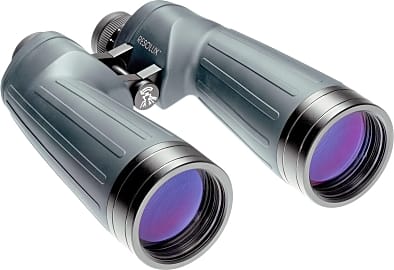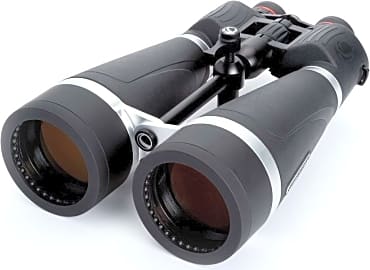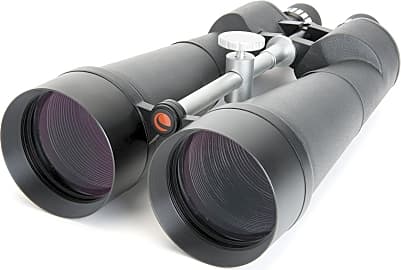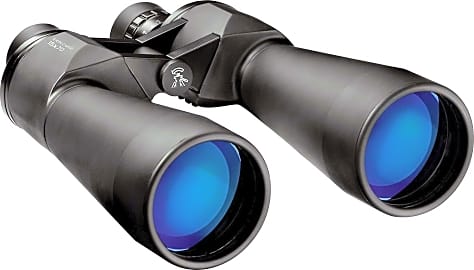The 8 Best Astronomy Binoculars

This wiki has been updated 32 times since it was first published in February of 2017. Ever since ancient times, mankind has gazed up at the skies in wonder, and some of our most profound discoveries came from people who had little more than their eyes and their wits with which to consider the cosmos. But the astronomy binoculars on our list give modern-day stargazers capabilities the geniuses of old could only have dreamt of, bringing the mysteries of space closer than ever before. When users buy our independently chosen editorial recommendations, we may earn commissions to help fund the Wiki.
Editor's Notes
July 22, 2020:
Due to limitations in availability, we've relegated the Oberwerk brand to our special honors section, but that by no means is a knock on their quality. We also sent off the Celestron Cometrons for limitations in both their magnification (7x) and their light gathering area (50mm), neither of which quite cross into the minimums we'd like to see in a astronomical binocular. We flirted with the idea or replacing them with a pair of zoomable binoculars from Nikon that could tackle a range between 8x and 22x, but the sacrifices in sharpness you get when you introduce a zoom make them untenable for committed stargazing.
Those two factors — magnification and light gathering — should be paramount in anyone's decision, but with so many offerings coming in at around 15x and 70mm, there are other aspects worth examining, as well. Construction quality is a big one, especially waterproofing. You might not be going out to look at the stars when it's overcast, but if a storm should move in quickly, or if dew were to settle on them in those pre-dawn hours when so many comets are at their most visible, you could risk damage if you don't have water resistance. Many models are at least nitrogen-purged, so if ambient moisture were to threaten the inside of the barrels, they would resist it that way.
June 25, 2019:
While time hasn't seen fit to remove any of our old items from this new ranking, we have included a few additional products that we believe warrant serious consideration by stargazers. In the number one spot, you'll find the Celestron Echelon 20 x 70, which are not only hand-assembled in the USA, but that are extremely rugged and waterproof, making them ideal for anyone who travels into the wilderness to escape light pollution. It's also decidedly cool that they come with a smartphone adapter, so you can record your images of the heavens. We also added a great pair from Oberwerk that doesn't quite boast the magnification of the Celestrons at number one, but whose excellent coatings do a great job to minimize light scattering so you get less of that halo effect when viewing particularly bright objects, especially the moon. Quite possibly the biggest loser on this round of rankings is the Cometron, also by Celestron. Thet're a fine pair, to be sure, but their focusing difficulties and relatively paltry 50mm objectives made them less than ideal for all but those astronomers who find themselves on particularly tight budgets.
Special Honors
Oberwerk 25 x 100 Deluxe This model is available with individually focusing eyepieces or with a center focus, depending on your preference. Their floating prism plates do a good job maintaining alignment, which is ideal if you don't want to have to collimate them yourself. They boast an all-metal construction with a rubber exterior armor, as well as a good amount of water-resistance. oberwerk.com
What Makes A Great Pair Of Astronomy Binoculars
As the magnification power of binoculars increases, the field of view generally decreases.
The first step to choosing the right pair of binoculars is understanding what all of the different specifications mean. The most prominent specification notated on binoculars, and one of the most important, is a figure that looks something like 10x70 or 25x100. These two numbers represent magnification and lens diameter. The first number is the amount of times a particular pair of binoculars can magnify an image. The second number is the size of the objective lens, which is measured in millimeters. The objective lens is the one at the end of the binoculars closest to the object you are viewing. So a pair of binoculars labeled as 25x100 would make an image look 25 times closer than it actually is and have an objective lens diameter of 100 millimeters. The objective lens is responsible for gathering light, and the larger it is, the more light it can gather and the brighter the image will appear. Since there is not a lot of light in space, it is important to choose a pair of astronomy binoculars with a large lens diameter.
Some models have an adjustable zoom feature, which allows you to adjust the magnification according to your needs. If you see a pair of binoculars with specs that look like 10-30x100, this means they have an adjustable zoom feature with the minimum magnification being 10 times, and the maximum magnification being 30 times.
The next most important specification on binoculars is the field of view. It will be represented in one of two ways: feet at a distance of 1,000 yards, or degrees. The higher the number of feet at 1,000 yards, the larger the field of view. When expressed in degrees, the higher the number of degrees, the larger the field of view. As the magnification power of binoculars increases, the field of view generally decreases. If you prefer the immersive space walking experience, choose a model with a wider field of view. This will make it easier to pan across the sky and find different celestial objects to view. If you prefer to see those celestial objects in the maximum amount of detail, opt for a pair with a narrower field of view and stronger magnification capabilities.
Binoculars Versus Telescopes For Viewing Celestial Objects
While telescopes have traditionally been the go-to device for viewing the heavens, binoculars actually offer a few distinct advantages. One of the biggest drawbacks of telescopes is their size. Even a small telescope is much larger than your average pair of binoculars. This seriously hinders their portability. If you are taking a multi-day camping and hiking trip, lugging along a giant telescope would be impractical for nighttime stargazing.
Seeing more of the night sky at once also gives you a better appreciation of how objects relate to one another in size and distance.
The large size of a telescope also makes a tripod almost a necessity. Since telescopes are so long, the arm holding the far end will be almost fully extended. This makes it nearly impossible to hold one without creating a lot of lens shake. Binoculars sit close to the face, making it easier to hold them steady.
As we touched on in the previous section, the greater the magnification capabilities, the lesser the field of view. Since telescopes are generally more high-powered than binoculars, they are notorious for having a very limited field of view. If you know exactly where the celestial objects you plan on viewing will be, this may be less of an issue, but if you need to scan the sky to find planets and stars, this can be very problematic. Seeing more of the night sky at once also gives you a better appreciation of how objects relate to one another in size and distance.
One of the greatest advantages of binoculars comes from their very design. Unlike with a telescope, with binoculars you get to view space with two eyes. This is very important to give your brain the full visual experience. Not only does single-eye viewing severely hamper your depth perception, it also decreases your signal-to-noise ratio, which is not a good thing. When you have a high signal-to-noise ratio, your brain filters out much of the unwanted random impulses from each eye, leaving you with a better view of whatever objects you are looking at. In fact, many astronomers claim that color perception and contrast is improved by as much as 40 percent when using binoculars over a telescope.
A Brief History Of Astronomy
Humans have had an interest in astronomy since ancient times. Prominent Greek writers as far back as the 7th century B.C.E. mention identifiable stars and constellations in their work. Homer mentions the constellations Orion and Ursa Major in the Iliad and the Odyssey, along with the star cluster Hyades and Sirus, the dog star. Hesiod writes of the star Arcturus in his poetic calendar Works and Days.
Around the same time, Galileo was beginning his study of celestial beings with the aid of a telescope, leading him to discover Jupiter's four brightest moons.
Civilizations such as the ancient Chinese, Mayans, and Harappans used astronomy to orient their cities and track time as early as 2000 B.C.E. Records also show evidence of some civilizations trying to use astronomy to predict the future. Most early forms of astronomy incorporated both careful study of the night sky and religion.
When Europe was blundering its way through the Dark Ages, Middle Eastern Astronomers were translating Greek texts that named and plotted the positions of stars into the Arabic language, helping to ensure the preservation of humanity's knowledge of the night sky. It is human's knowledge of the position of celestial objects, such as the North Star, that made ocean exploration possible. Determining a ship's heading without these navigational aids was considerably more difficult and less accurate.
The true renaissance of astronomy began when Nicholaus Copernicus proposed that the sun was at the center of the universe in the 16th century C.E. Less than 100 years later, Johannes Kepler introduced the Three Laws of Planetary Motion. Around the same time, Galileo was beginning his study of celestial beings with the aid of a telescope, leading him to discover Jupiter's four brightest moons. Astronomers have continued to make great strides in our understanding of the universe, discovering the first planets outside of our Solar System as recently as 1991.













